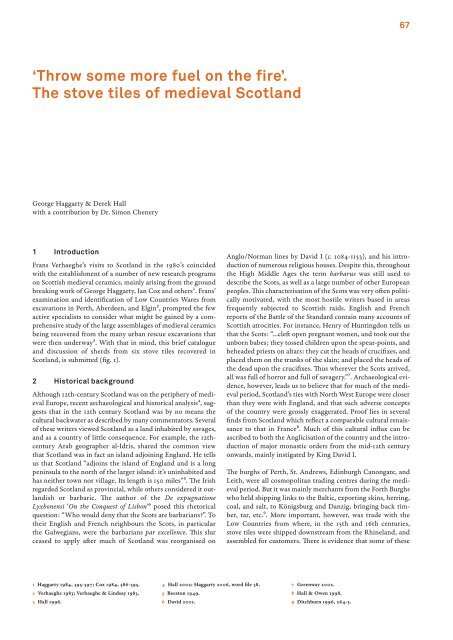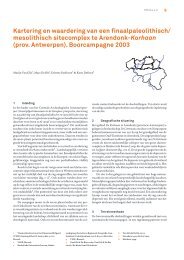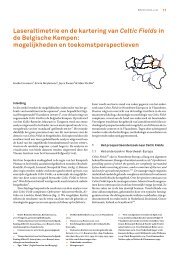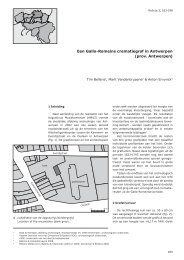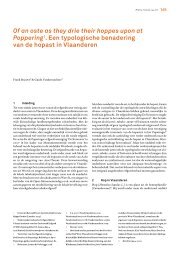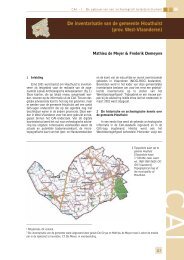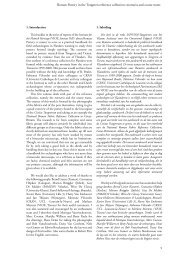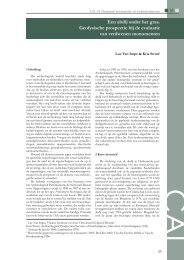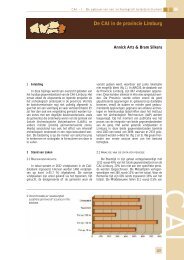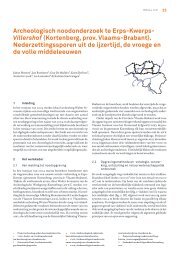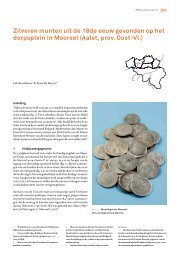Exchanging Medieval Material Culture Studies on archaeology and ...
Exchanging Medieval Material Culture Studies on archaeology and ...
Exchanging Medieval Material Culture Studies on archaeology and ...
You also want an ePaper? Increase the reach of your titles
YUMPU automatically turns print PDFs into web optimized ePapers that Google loves.
‘Throw some more fuel <strong>on</strong> the fire’.<br />
The stove tiles of medieval Scotl<strong>and</strong><br />
George Haggarty & Derek Hall<br />
with a c<strong>on</strong>tributi<strong>on</strong> by Dr. Sim<strong>on</strong> Chenery<br />
1 Introducti<strong>on</strong><br />
Frans Verhaeghe’s visits to Scotl<strong>and</strong> in the 1980’s coincided<br />
with the establishment of a number of new research programs<br />
<strong>on</strong> Scottish medieval ceramics, mainly arising from the ground<br />
breaking work of George Haggarty, Ian Cox <strong>and</strong> others1. Frans’<br />
examinati<strong>on</strong> <strong>and</strong> identifi cati<strong>on</strong> of Low Countries Wares from<br />
excavati<strong>on</strong>s in Perth, Aberdeen, <strong>and</strong> Elgin2, prompted the few<br />
active specialists to c<strong>on</strong>sider what might be gained by a comprehensive<br />
study of the large assemblages of medieval ceramics<br />
being recovered from the many urban rescue excavati<strong>on</strong>s that<br />
were then underway3. With that in mind, this brief catalogue<br />
<strong>and</strong> discussi<strong>on</strong> of sherds from six stove tiles recovered in<br />
Scotl<strong>and</strong>, is submitted (fi g. 1).<br />
2 Historical background<br />
Although 12th-century Scotl<strong>and</strong> was <strong>on</strong> the periphery of medieval<br />
Europe, recent archaeological <strong>and</strong> historical analysis4, suggests<br />
that in the 12th century Scotl<strong>and</strong> was by no means the<br />
cultural backwater as described by many commentators. Several<br />
of these writers viewed Scotl<strong>and</strong> as a l<strong>and</strong> inhabited by savages,<br />
<strong>and</strong> as a country of little c<strong>on</strong>sequence. For example, the 12thcentury<br />
Arab geographer al-Idris, shared the comm<strong>on</strong> view<br />
that Scotl<strong>and</strong> was in fact an isl<strong>and</strong> adjoining Engl<strong>and</strong>. He tells<br />
us that Scotl<strong>and</strong> “adjoins the isl<strong>and</strong> of Engl<strong>and</strong> <strong>and</strong> is a l<strong>on</strong>g<br />
peninsula to the north of the larger isl<strong>and</strong>: it’s uninhabited <strong>and</strong><br />
has neither town nor village. Its length is 150 miles”5. Th e Irish<br />
regarded Scotl<strong>and</strong> as provincial, while others c<strong>on</strong>sidered it outl<strong>and</strong>ish<br />
or barbaric. Th e author of the De expugnati<strong>on</strong>e<br />
Lyxb<strong>on</strong>ensi ‘On the C<strong>on</strong>quest of Lisb<strong>on</strong>’6 posed this rhetorical<br />
questi<strong>on</strong>: “Who would deny that the Scots are barbarians?”. To<br />
their English <strong>and</strong> French neighbours the Scots, in particular<br />
the Galwegians, were the barbarians par excellence. Th is slur<br />
ceased to apply aft er much of Scotl<strong>and</strong> was reorganised <strong>on</strong><br />
1 Haggarty 1984, 395-397; Cox 1984, 386-395.<br />
2 Verhaeghe 1983; Verhaeghe & Lindsay 1983.<br />
3 Hall 1996.<br />
4 Hall 2002; Haggarty 2006, word fi le 38.<br />
5 Beest<strong>on</strong> 1949.<br />
6 David 2001.<br />
7 Greenway 2002.<br />
8 Hall & Owen 1998.<br />
9 Ditchburn 1996, 264-5.<br />
67<br />
Anglo/Norman lines by David I (c. 1084-1153), <strong>and</strong> his introducti<strong>on</strong><br />
of numerous religious houses. Despite this, throughout<br />
the High Middle Ages the term barbarus was still used to<br />
describe the Scots, as well as a large number of other European<br />
peoples. Th is characterisati<strong>on</strong> of the Scots was very oft en politically<br />
motivated, with the most hostile writers based in areas<br />
frequently subjected to Scottish raids. English <strong>and</strong> French<br />
reports of the Battle of the St<strong>and</strong>ard c<strong>on</strong>tain many accounts of<br />
Scottish atrocities. For instance, Henry of Huntingd<strong>on</strong> tells us<br />
that the Scots: “…cleft open pregnant women, <strong>and</strong> took out the<br />
unborn babes; they tossed children up<strong>on</strong> the spear-points, <strong>and</strong><br />
beheaded priests <strong>on</strong> altars: they cut the heads of crucifi xes, <strong>and</strong><br />
placed them <strong>on</strong> the trunks of the slain; <strong>and</strong> placed the heads of<br />
the dead up<strong>on</strong> the crucifi xes. Th us wherever the Scots arrived,<br />
all was full of horror <strong>and</strong> full of savagery.”7. Archaeological evidence,<br />
however, leads us to believe that for much of the medieval<br />
period, Scotl<strong>and</strong>’s ties with North West Europe were closer<br />
than they were with Engl<strong>and</strong>, <strong>and</strong> that such adverse c<strong>on</strong>cepts<br />
of the country were grossly exaggerated. Proof lies in several<br />
fi nds from Scotl<strong>and</strong> which refl ect a comparable cultural renaissance<br />
to that in France8. Much of this cultural infl ux can be<br />
ascribed to both the Anglicisati<strong>on</strong> of the country <strong>and</strong> the introducti<strong>on</strong><br />
of major m<strong>on</strong>astic orders from the mid-12th century<br />
<strong>on</strong>wards, mainly instigated by King David I.<br />
Th e burghs of Perth, St. Andrews, Edinburgh Can<strong>on</strong>gate, <strong>and</strong><br />
Leith, were all cosmopolitan trading centres during the medieval<br />
period. But it was mainly merchants from the Forth Burghs<br />
who held shipping links to the Baltic, exporting skins, herring,<br />
coal, <strong>and</strong> salt, to Königsburg <strong>and</strong> Danzig, bringing back timber,<br />
tar, etc.9. More important, however, was trade with the<br />
Low Countries from where, in the 15th <strong>and</strong> 16th centuries,<br />
stove tiles were shipped downstream from the Rhinel<strong>and</strong>, <strong>and</strong><br />
assembled for customers. Th ere is evidence that some of these


